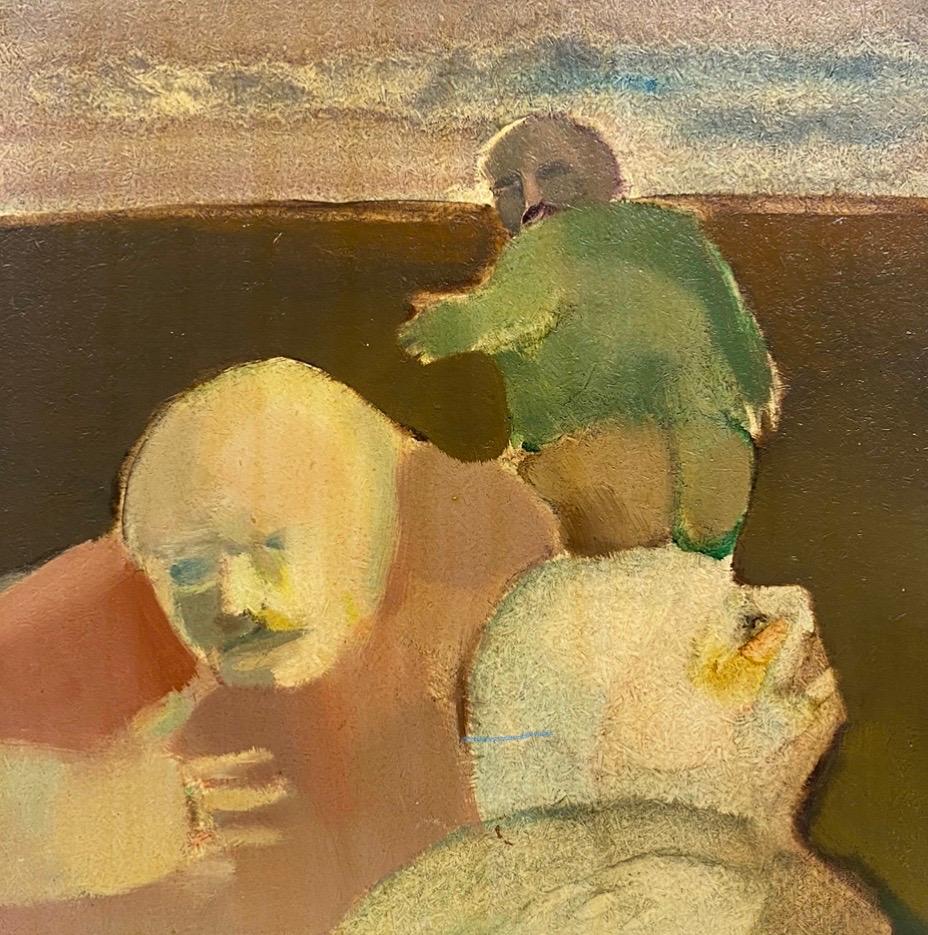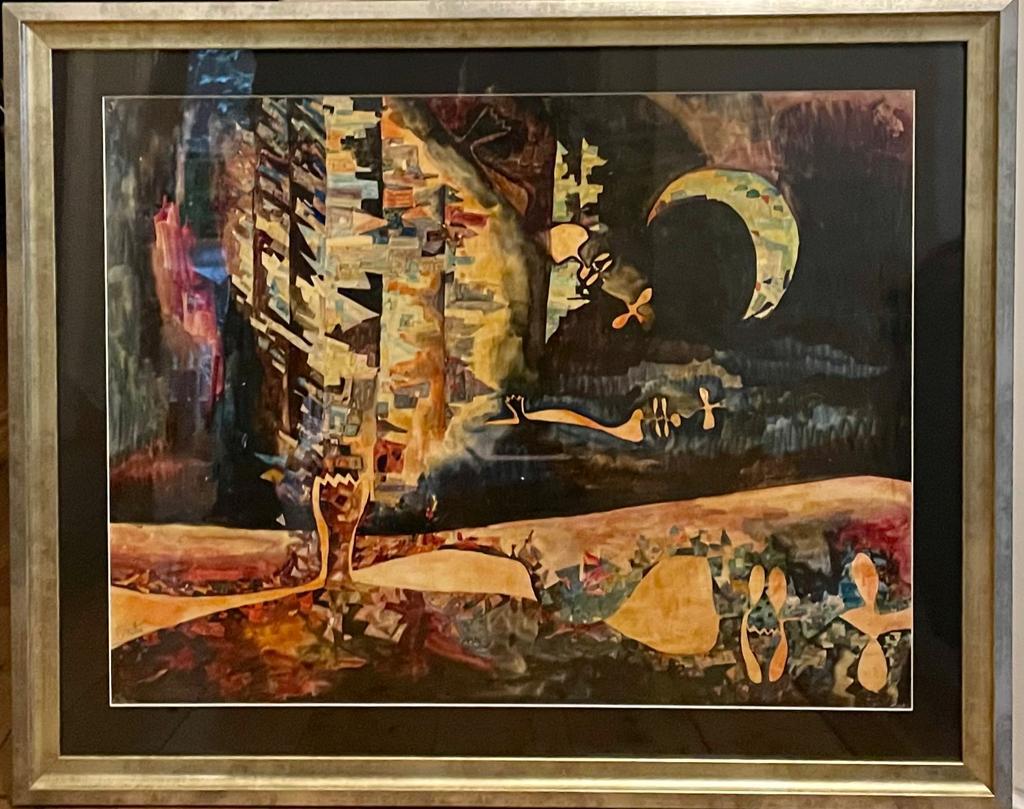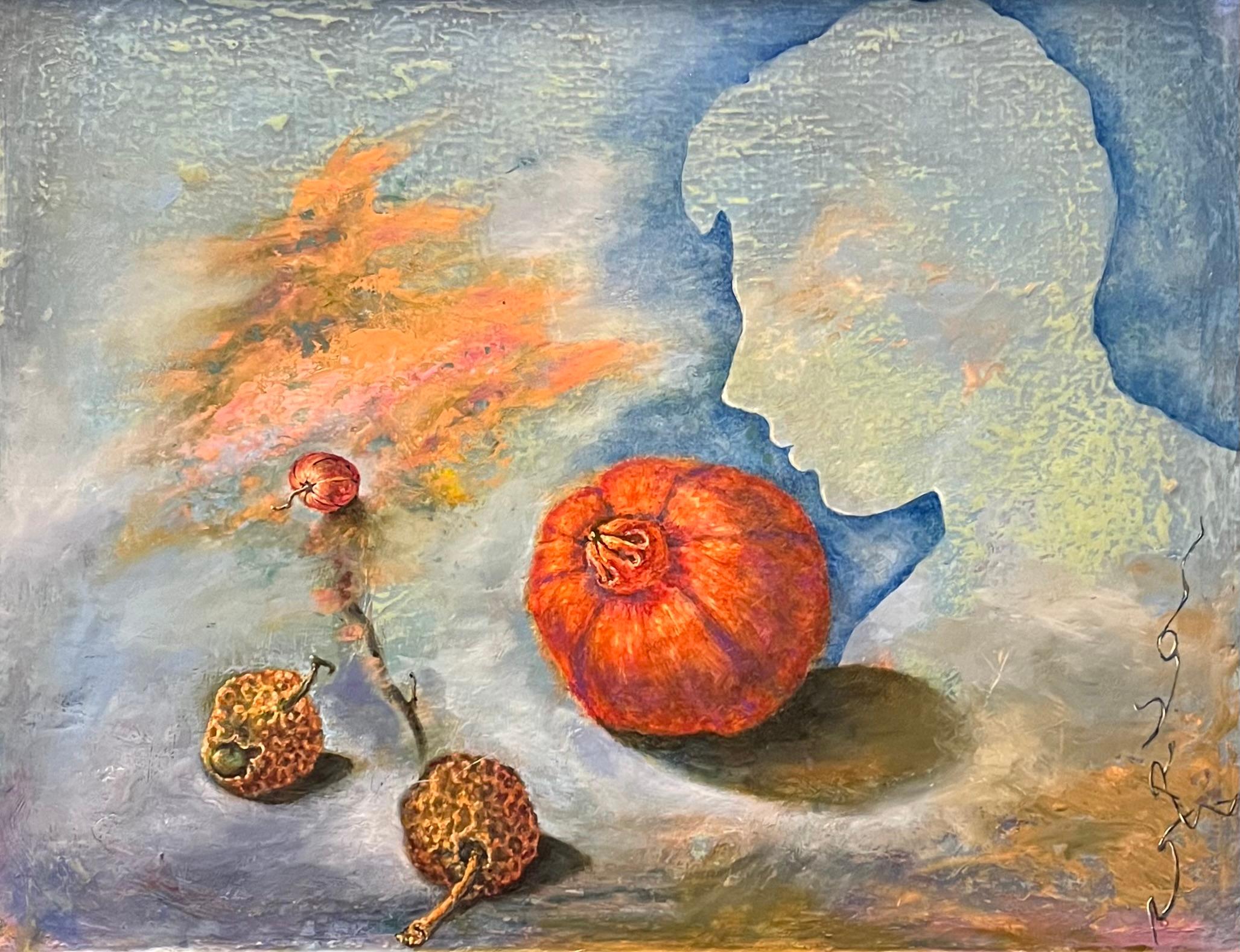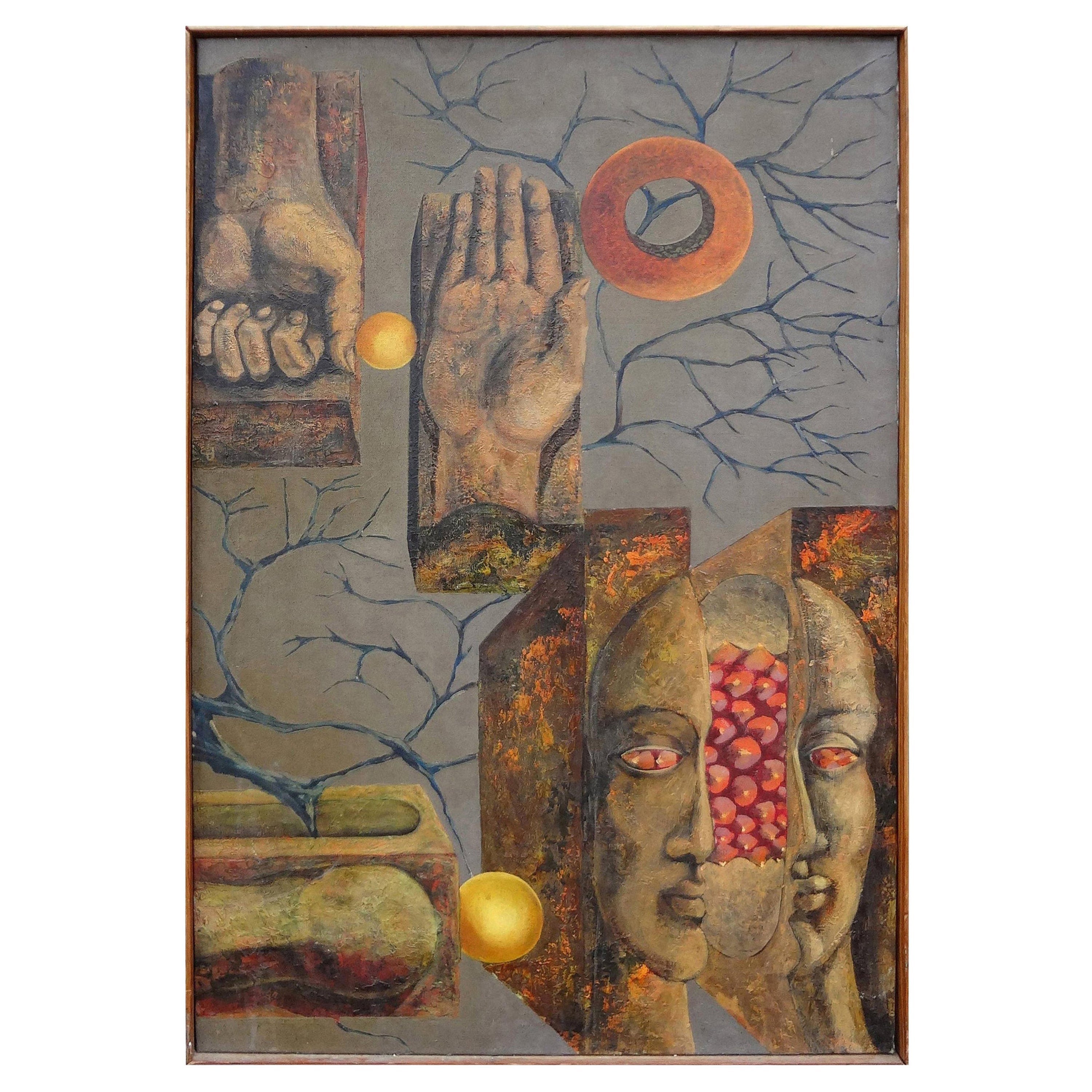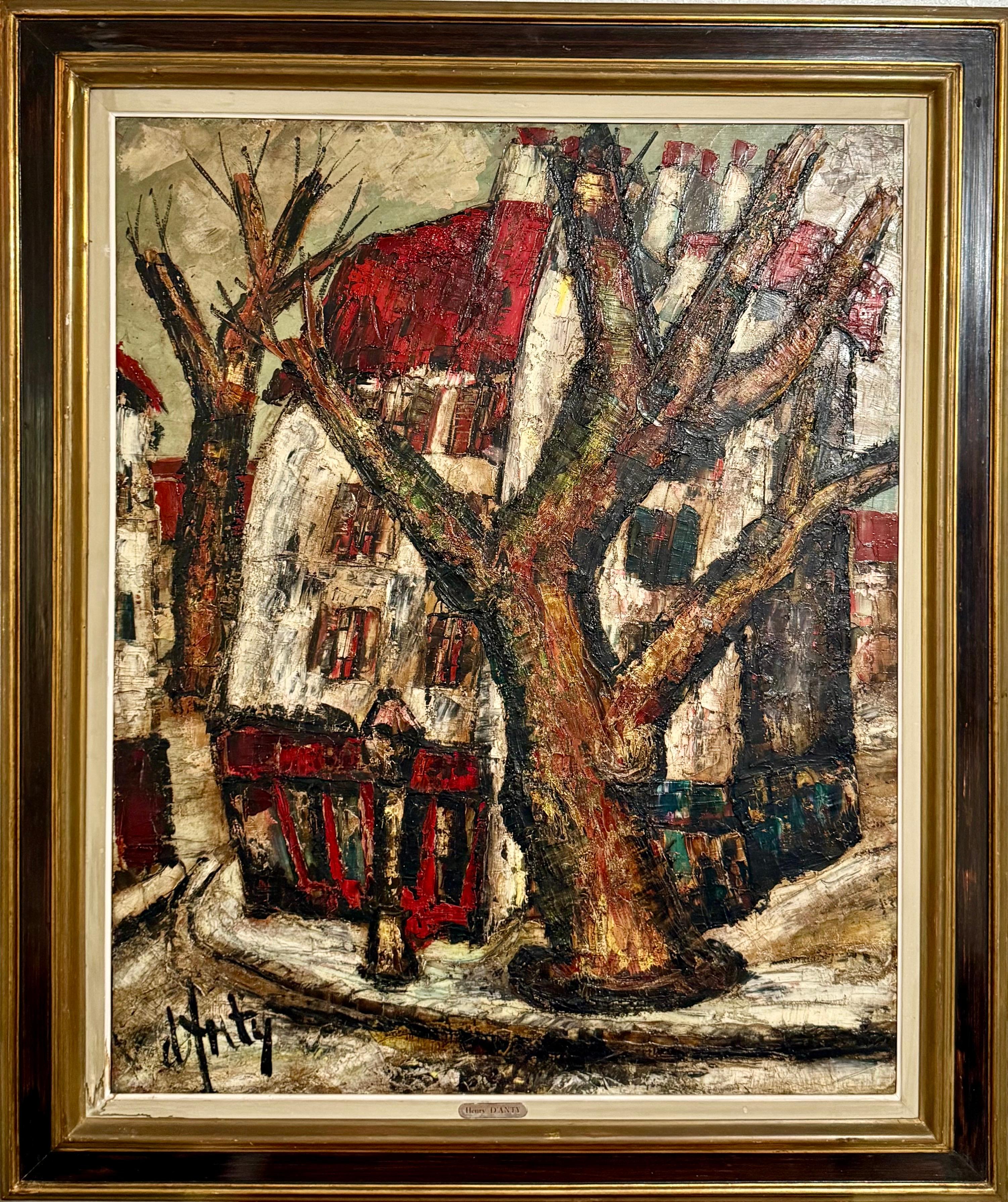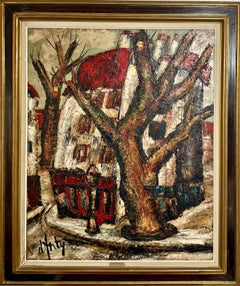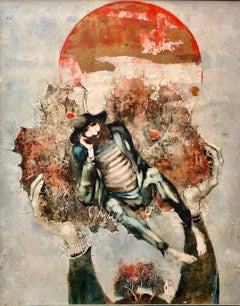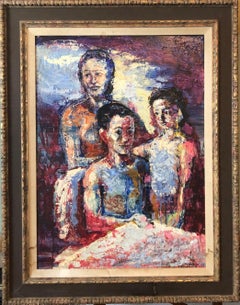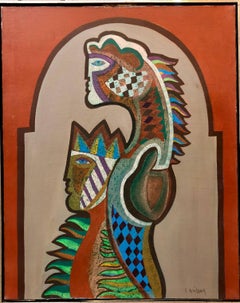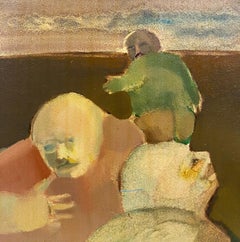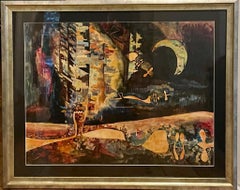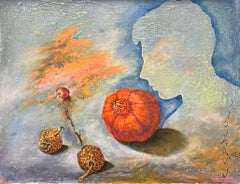Items Similar to Large Surrealist French Expressionist Oil Painting Moody Boys Pierre Henry
Want more images or videos?
Request additional images or videos from the seller
1 of 18
Pierre HenryLarge Surrealist French Expressionist Oil Painting Moody Boys Pierre Henryc. 20th century
c. 20th century
$3,600
£2,724.64
€3,128.43
CA$5,128.50
A$5,561.98
CHF 2,921.36
MX$67,560.03
NOK 36,556.23
SEK 34,419.73
DKK 23,355.92
About the Item
Pierre Henry (1924 - 2015)
Hand signed lower right.
Dimensions: (Frame) H 39" x W 33" ; (Painting) H 31.5" x W 25.5"
Oil on board painting depicting two people, a man holding a guitar and a boy with a paper hat in front of important architecture buildings in the polychrome background.
Pierre-Henry sociétaire des grands Salons à Paris et vice-président de la Société Nationale des Beaux-Arts.
PIerre Henry studied painting, the art of fresco and of etching in the Ecole Nationale Supérieure des Beaux Arts, in Paris. Since 1950, his first exhibition, his talent led him to become one of the leaders of the French figurative expressionist school. He was of the period of Jean jansem, Pierre Serrier and Bernard Buffet
"I believe that the artists, painters, poets, and musicians, are our society’s prophets, its preachers. They bear witness to their anguish face to face with humanity in total confusion, which feels and knows it is threatened.
At first smooth, the painting slowly acquires reliefs. The lacquer color is dazzling and the backgrounds alone make up genuine paintings. That especially sumptuous texture emphasizes their graphic precision.
Smooth paint, flattened out, provides a lacquered effect, and brings to mind the great Flemish masters’ works.
Of the generation of great post war French artists he has shown with Jean Pierre Alaux, Lucien Philippe Moretti, Edouard Pignon, Henri Michaux, Guy Cambier, Jean Fusaro, Mara Tran Long, Claude Mourier, Herick Michaud, Tony Buller French figurative expressionism painter. Pierre Clément Didier Henry is a member of the major Salons in Paris and vice-president of the Société Nationale des Beaux-Arts.
In his father Clément Henry's bakery, located rue Saint-Denis in Paris, Pierre-Henry had developed the habit of drawing. Noticed by the painter Martin Roch who introduced him to André Marchand, Gertrude Stein and the writer Blaise Cendrars, this made him want to study painting, the art of frescoes and engraving.
Pierre-Henry took courses at the École nationale supérieure des beaux-arts in Paris and studied painting at the Poujon workshop who, appointed director of the Casa de Velázquez, left the workshop to Jean Dupas.
He was notably a friend of the painters Maurice Boitel, Daniel du Janerand, Jean-Pierre Alaux, and André Sablé, of the Young Painting of the New School of Paris. Influenced by Expressionism and Surrealism
His favorite themes are love, war, time, life, death constantly mixed together, destiny, as well as still lifes. His works are generally very colorful. He is renowned as one of the leaders of the contemporary color figurative school. Patrice de La Perrière of the magazine Univers des Arts, defined him as an artist who poses “a look dressed in poetic inventions”.
Many private collections around the world host works by Pierre-Henry, as well as the Paris Museum of Modern Art, the Toulouse-Lautrec Museum , the Annecy Museum, the Hôtel d'Aumont, the Palais de Élysée, the Neuilly Customs School, the Fleischman Foundation, the French Embassy in Pretoria, the Boston Museum, the Paul Valéry Museum in Sète, the Hôtel de Région in Montpellier , and a large donation from Josette Henry to the Gard Museum of Sacred Art, in Pont-Saint-Esprit.
Among his works, we can cite The Eternal Prisoner (1949), Portrait of Dr. Albert Schweitzer (1956), The Woman with the Suns, The Lovers (1963), Death (1963), The Sleeping Beauty (1965), The man prisoner of war (tribute to Félicien Challaye who died inApril 1967), La Cévenne (1968), The game is not over, Terre des hommes (1975), Sunflowers, The benefits of water (1976), Bouquet(s), The flower festival (1977), The happiness of this world (1980), The awakening of spring (1982), The thread of life (2004), Portrait of Carlina.
He has won numerous prizes including the Pierre Puvis de Chavannes prize awarded by the Société nationale des beaux-arts.
Select Awards
1947 - Logist for the Grand Prix de Rome .
1949 - A Hallmark award allows him to discover Italy
1955 - Drouant-David Young Painting Prize
1956 - Portrait of Dr. Albert Schweitzer for the Witness Painters of their Time, Galliera museum
1968 - Puvis de Chavannes Prize
1970 - Grand Prix for Painters Witnesses of their Time, Galliera museum
1980 - International Gemmail Prize
1983 - Grand Prix de l’Orangerie de Versailles
He created the characters for a puppet film, Moses , which won an award at the first Venice Biennale.
Exhibitions
to modify
His first exhibition, at the Galerie Saint Placide in Paris, dates from 1950. He exhibited notably at the Salon "Compariisons" ( Jean-Pierre Alaux 's group ), at the Salon des indépendants , at the Salon de la Société nationale des Beaux-Arts , at the Autumn Fair .
His other exhibitions:
1968 - Retrospective at the Museum of Modern Art of the City of Paris
1987 - Retrospective exhibition, Lons-le-Saunier museum
1989 - Retrospective exhibition, Paul Valéry museum in Sète
1989 - Tribute awarded by the Salon d'Automne, Grand Palais , Paris
1990 - Guest of honor at the Air and Space Show, Jacobins Museum, Toulouse
1993 - Retrospective exhibition, Gemmail museum, Tours
1995 - Exhibition at the castle-museum of Gaasbeek (Belgium)
1995 - Tribute to the Salon du Dessin, Espace Branly, Paris
1996 - Retrospective exhibition, Musée du Colombier, Alès
2003 - Haus Ludwig Museum, Saarlouis (Germany)
2005 - Retrospective exhibition, at the Moulins Albigeois , Albi
2009 - Exhibition in the Marcel Pagnol room, at Grand'Combe
2012 - Exhibition at the Albert-André Museum in Bagnols-sur-Cèze
2015 - Exhibition at the Château de Vascoeuil
2017 - Exhibition at the Sacred Art Museum of Gard , in Pont-Saint-Esprit
Pierre-Henry is also exhibited at the Galerie Henot in Enghien le Bains.
Book Monographs
1973 - Book prefaced by Bernard Clavel published by Graphic Arts of Aquitaine,
1987 - Brochure, The Universe of Pierre Henry , Ed. Terre des Peintres
2017 - Pierre Henry, Hommage, catalog of the Museum of Sacred Art of Gard , published by the department of Gard
- Creator:Pierre Henry (1924 - 2015)
- Creation Year:c. 20th century
- Dimensions:Height: 39 in (99.06 cm)Width: 33 in (83.82 cm)
- Medium:
- Period:
- Condition:Slight craquelure to the paint as typical, please refer to photos.
- Gallery Location:Surfside, FL
- Reference Number:1stDibs: LU38214736462
About the Seller
4.9
Platinum Seller
Premium sellers with a 4.7+ rating and 24-hour response times
Established in 1995
1stDibs seller since 2014
1,814 sales on 1stDibs
Typical response time: 1 hour
- ShippingRetrieving quote...Shipping from: Surfside, FL
- Return Policy
Authenticity Guarantee
In the unlikely event there’s an issue with an item’s authenticity, contact us within 1 year for a full refund. DetailsMoney-Back Guarantee
If your item is not as described, is damaged in transit, or does not arrive, contact us within 7 days for a full refund. Details24-Hour Cancellation
You have a 24-hour grace period in which to reconsider your purchase, with no questions asked.Vetted Professional Sellers
Our world-class sellers must adhere to strict standards for service and quality, maintaining the integrity of our listings.Price-Match Guarantee
If you find that a seller listed the same item for a lower price elsewhere, we’ll match it.Trusted Global Delivery
Our best-in-class carrier network provides specialized shipping options worldwide, including custom delivery.More From This Seller
View AllFrench Modernist Large Paris Street Oil Painting Expressionist Henry D'anty
By Henri d'Anty
Located in Surfside, FL
Large oil on canvas Paris, France street scene with house and tree.
Hand signed
Framed Dimensions 41 x 48.5 Canvas is 40 X 32 inches
Henri Maurice D'Anty, listed French artist, Henry d'Anty 1910-1998
Born 1910 in Belleville France. Died in December 4 1998.
Educated at the Académie de la Grande Chaumière and the Académie Julian Paris. Painter of the school of Paris. ((painter of de l'Ecole de Paris et Peintre Témoin de son Temps) He participated in numerous exhibitions and was rewarded number of prizes for his work in France and abroad
D'Anty was born in Belleville, and it was here that he came to know the picturesque architectural quality of small sloping streets, sometimes broken by flights of steps, like those of Montmartre. Afterwards he moved to Saint Maurice, where he came under the spell of the banks of the Marne with its blue green reflections, the heavy river barges, sail boats, and the lock with its large dark mass, which all made their impressions, as did a later visit in northern France, long before he thought seriously about painting. But in both eye and mind, he was already storing secret visions and emotions.
During a holiday in Brittany, he discovered an entirely new awareness of colors, or rather of colors of the enchanting, subtle tones which make up the varied atmospheres of the Breton scene. He is linked to both post impressionism and expressionism. He was part of the Ecole de Paris (School of Paris) and showed with Francois Arnal, Franz Priking, Isis Kischka, Roland Dubuc, Bernard Maurice Quentin, Michel Patrix, Roger Bezombes, Lucien Joseph Fontanarosa, Bernard Buffet, Jean Marzelle, Maurice Blond, Isaac Antcher, Francis Bott, Jean Jansem, Alfred Charles Weber...
Category
20th Century Expressionist Landscape Paintings
Materials
Canvas, Oil
Mid Century Hungarian Gilt Oil Painting on Board Modern Judaica
Located in Surfside, FL
From a collection by a long time Miami Beach art dealer on the old Lincoln Rd. This is a piece he brought back from hungary. from a collection of good Hungarian artists and Illustrat...
Category
20th Century Modern Figurative Paintings
Materials
Oil, Board
Family Portrait, Large Surrealist Oil Painting Mother, Children, Neo Surrealism
Located in Surfside, FL
Hank Laventhol (1927–2001) was an American painter and master print maker. He worked in painting, graphics, sculpture and photography. Associated with ...
Category
1950s Surrealist Figurative Paintings
Materials
Oil, Board
Surrealist Woman Oil painting French-Moroccan Israeli Bezalel School Painter
By Simon Avissar
Located in Surfside, FL
Two Women. Colorful Surrealist Portrait
Genre: Surrealism
Subject: woman
Medium: Oil
Surface: Canvas
Country: Israel
Simon Avissar, painter, born 1948, Morocco. Moved to U.S.A. Wo...
Category
20th Century Surrealist Figurative Paintings
Materials
Canvas, Oil
Large Naive European Folk Art Oil Painting Jovan Obican Klezmer Jazz Musician
By Jovan Obican
Located in Surfside, FL
Genre: Other
Subject: People
Medium: Oil
Surface: Canvas
Dimensions: 35" x 16.5
Dimensions w/Frame: 35.5" x 17.25
This depicts a Jazz or Klezmer musician. This one is a banjo or guitar player.
The last photo shows it in a group of three that I have available. This listing is for the one painting.
The artist Jovan Obican iconic style is child-like yet masterfully adult; a style that tells a story with sociological overtones. His funny little people are always colorful, full of spirit, living with music and birds to bring them happiness.
JOVAN OBICAN
Cannes, France, b. 1918, d. 1986
Jovan Obican (1918-1986) artist, painter, sculpture and mosaic ceramic artisan was born in Cannes, France, to his Yugoslavian parents. From childhood on, Jovan practically devoted himself to art, scratching designs into the dirt when paper was unavailable. He trained with many recognized teachers and with many styles. He finished his training, imbued with the spirit of his native country, the people, their legends, and their philosophy. It has been said that his work has a "timeless quality" and a naive, folk art, outsider art brut quality, child-like primitive style. Obican is identified with his style the world over, a style that is simple yet sophisticated; child-like yet masterfully adult; a style that tells a story with psychological, philosophical or sociological overtones. His funny little people are always colorful, full of spirit, living with music and birds to bring them happiness. Best known for his depictions of folklore and traditional costumes rendered in a playful, childlike style and for his happy Jewish wedding scenes. He often used bright colors and black outlines in his renderings of figures and animals, giving his work an illustration-like quality. Thematically, the artist’s work is similar to Marc Chagall and Jean Dubuffet for its dreamlike images and so-called naïve style of painting. Over the course of his career, the artist maintained a studio in Boca Raton, Florida and Dubrovnik, Croatia—part of former Yugoslavia— where he developed an interest in Eastern Europe’s Jewish culture. Many of his mature works depict Jewish traditions and ceremonies, including traditional Jewish weddings, the dancing of the Hora, and traditional music. There is a display of his works in his former Dubrovnik studio.
His style is a unique conglomerate of tradition, history, legends, heroes, old customs and folklore. It is a self-standing style, recognizable, cheerful, whimsical and a happy creation. Naïve art is any form of visual art that is created by a person who lacks the formal education and training that a professional artist undergoes (in anatomy, art history, technique, perspective, ways of seeing). Unlike folk art, naïve art does not necessarily evince a distinct cultural context or tradition. Naïve art is recognized, and often imitated, for its childlike simplicity and frankness. Paintings of this kind typically have a flat rendering style with a rudimentary expression of perspective.
One particularly influential painter of "naïve art" was Henri Rousseau (1844–1910), a French Post-Impressionist who was discovered by Pablo Picasso. Naïve art is often seen as outsider art that is by someone without formal (or little) training or degree. While this was true before the twentieth century, there are now academies for naïve art. Naïve art is now a fully recognized art genre, represented in art galleries worldwide.
Museums devoted to naïve art now exist in Kecskemét, Hungary; Riga, Latvia; Jaen, Spain; Rio de Janeiro, Brasil; Vicq France and Paris. "Primitive art" is another term often applied to art by those without formal training, but is historically more often applied to work from certain cultures that have been judged socially or technologically "primitive" by Western academia, such as Native American, sub saharan African or Pacific Island art (see Tribal art). This is distinguished from the self-conscious, "primitive" inspired movement primitivism. Another term related to (but not completely synonymous with) naïve art is folk art. There also exist the terms "naïvism" and "primitivism" which are usually applied to professional painters working in the style of naïve art (like Paul Gauguin, Mikhail Larionov, Paul Klee).
At all events, naive art can be regarded as having occupied an "official" position in the annals of twentieth-century art since - at the very latest - the publication of the Der Blaue Reiter, an almanac in 1912. Wassily Kandinsky and Franz Marc, who brought out the almanac, presented 6 reproductions of paintings by le Douanier' Rousseau (Henri Rousseau), comparing them with other pictorial examples. However, most experts agree that the year that naive art was "discovered" was 1885, when the painter Paul Signac became aware of the talents of Henri Rousseau and set about organizing exhibitions of his work in a number of prestigious galleries. The Earth Group (Grupa Zemlja) were Croatian artists, architects and intellectuals active in Zagreb from 1929 to 1935. The group included the painters Krsto Hegedušić, Edo Kovačević, Omer Mujadžić, Kamilo Ružička, Ivan Tabaković, and Oton Postružnik, the sculptors Antun Augustinčić, Frano Kršinić, and the architect Drago Ibler. A term applied to Yugoslav (Croatian) naive painters working in or around the village of Hlebine, near the Hungarian border, from about 1930. Some of the best known naive artists are Dragan Gaži, Ivan Generalić, Josip Generalić, Krsto Hegedušić, Mijo Kovačić, Ivan Lacković-Croata, Franjo Mraz, Ivan Večenaj and Mirko Virius. Camille Bombois (1883–1970) Ferdinand Cheval, known as 'le facteur Cheval' (1836–1924) Henry Darger (1892–1973) L. S. Lowry (1887–1976) Grandma Moses, Anna Mary Robertson...
Category
20th Century Folk Art Figurative Paintings
Materials
Canvas, Oil
French Mod Surrealist Commedia dell'arte Circus Scene Oil Painting J.P. Serrier
By Jean Pierre Serrier
Located in Surfside, FL
Jean Pierre Serrier (French, 1934-1989)
Oil on canvas painting depicting four figures
Hand signed lower right.
Measures (frame) 26.5" x 30" wide, and (sight) 18.25." x 22.25" wide.
Jean Pierre Serrier (1934 – 1989) was a French painter known for surrealism and absurdist art. Jean-Pierre Serrier was born in Montparnasse, Paris and attended the Académie des Beaux-Arts in Paris.
the son of Louis and Solange Serrier. His father fought in World War II and became a prisoner of war. In 1940, as a six-year-old, he and his mother fled Paris for Corrèze in southwest France. Childhood memories of close escapes from German bombardments would later influence his absurdist philosophy of life. Passionate about drawing, in 1951 he applied and was admitted to the École nationale supérieure des arts appliqués et des métiers d'art in Paris. He shared an attic apartment in the 16th arrondissement with fellow student Jean-Baptiste Valadié. For income, he decorated shop windows. A trip to Spain provided motifs for early works. His student work might be characterized as art naïf (Naive art). While still a student, he sold a ceramic artwork to the poet and publisher Pierre Seghers, who would later commission drawings from him. He frequented jazz clubs in Saint-Germain des Près, and while listening to Sidney Bechet at the Vieux Colombier, he met his wife, Yvette.One of the last French Surrealist and follower of Nietzsche. His art conveyed the message to all of mankind that we are only human. The other Surrealist to center his art in philosophy was Rene Magritte whose paintings reflect his understanding of Sigmund Freud. He had his first exhibition in 1955, before being sent to Algeria to complete his military service. After graduating in 1955, he was drafted for military service, spent time in Germany and Morocco, and was sent to the front lines of the Algerian War. In 1959 he exhibited works at two Parisian galleries and at Juan-les-Pins on the Côte d'Azur. From 1961, he exhibited annually at the Salon des Artistes Français. In 1962, the City of Paris purchased his painting Un dimanche In 1961, Serrier made his first visit to the United States to exhibit at a New York gallery. In 1975 and 1979, he had successful exhibitions in New Orleans, and his work was included in art and news magazines, including Time and Newsweek.
Beginning in the 1950s, his works included stylized portraits similar in some ways to the "big eyes" art of Margaret Keane, though it is uncertain that either artist influenced the other. Keane painted children, and so did Serrier, sometimes from life, but Serrier’s models are usually somewhat older, though uniformly slender and with androgynous features.
A gallery owner introduced Serrier to American collectors Edgar Garbisch and his wife, Bernice Chrysler (daughter of Chrysler founder Walter P. Chrysler), who had a particular interest in naïve art; they commissioned a series of portraits from Serrier. At the same time, he met Reine Ausset in Paris, who in 1961 invited him to New York to take part in an exhibition at Galerie Norval on 57th Street. The show also included work by Moïse Kisling, and the exhibition program explicitly linked the two artists, saying that Serrier, who considered Moise Kisling "the Master," had found his own technique, but "the same vision joins the grand Kisling to the young Serrier: plenitude of shapes, sureness of palette, precision in outlines."
In the 1960s he began painting slender, young, androgynous figures in groups, set in sparse landscapes with suggestions of the surreal and sometimes wearing costumes of the Commedia dell'arte. In some of these paintings the eyes of the figures are completely black, a motif that would continue in his later work. In 1965, he exhibited at Forest and Reed Gallery in London. Also in 1965, he discovered the small town of Martel, and with his old roommate Jean-Baptiste Valadié purchased a house that they opened as the gallery La Licorne (The Unicorn) in 1967.
Responding to the political upheavals of May 1968 in France, and following the advice of Geneva gallery owner Roger Ferrero, Serrier's work became increasingly complex, idiosyncratic, and surreal. Imagery included the Tower of Babel, bodies suspended in space, and crowds of people all dressed alike, with identical features and entirely black eyes. Mannequins, playing cards, nudes, and levitating orbs also figured in the work. In a nod to Magritte, his men sometimes wear bowler hats. Another influence may have been the works of the Franco-Belgian surrealist Gaston Bogaert (1918-2008). Serrier's first major exhibit of these works, in Geneva in 1971, was titled Le Réalisme Fantastique. (Magic Realism)
In 1972, he was made a member of the Société du Salon d'Automne, under whose auspices he was invited by the Polish government to exhibit in Warsaw in 1973, as part of a cultural exchange across the Iron Curtain. In 1976, he served on the jury of the Salon d'Automne.
In 1975, New Orleans gallery owner Kurt E. Schon brought his work to several cities in the United States. A copiously illustrated monograph in English, Surrealism and the Absurd: Jean Pierre Serrier, was published in 1977. Author Thomas M. Bayer wrote: Serrier's world is one where—to use Friedrich Nietzche's term—the "human herd animal" is being confronted with the overwhelming task of coping with the world, his solitude, and at times, his resignation in the face of its monstrous size and duration. It is a world where the characterless, "blind" man faces the institutions, rules and symbols that made him into the being he now is…But Serrier does not lose himself in this world he portrays. He never forgets the old French tradition, the "black" humor, à la Molière. This classical humor at times is more felt than seen, in a manner that can be terribly funny, because it is horrifying, laughable, poignant and always true. Serrier told a friend, "In each of my paintings there's a message of hope amid the crowd of stereotypical figures. It could be an escaping dirigible, or a nymphet who flees like a deer under the red and blue trees of paradise...
Category
Mid-20th Century Surrealist Figurative Paintings
Materials
Canvas, Oil
You May Also Like
Large French Surrealist Oil Painting Male Figurative Scene
Located in Cirencester, Gloucestershire
Figurative Abstract
French School
small frame
oil painting on board
painting: 20.5 x 21 inches
overall size: 21x 21 inches
condition: overall very good and pleasing
provenance: from ...
Category
20th Century Surrealist Figurative Paintings
Materials
Oil
$1,072 Sale Price
20% Off
Father and son oil on canvas painting surrealist
By Ramon Llovet Miserol
Located in Sitges, Barcelona
Ramón Llovet (1917-1987) - Father and son - Oil on canvas
Canvas measures 50x61 cm.
Frame measures 56x67 cm.
Ramon Llovet Miserol (Barcelona, August 7, 1917 - Barcelona, August ...
Category
1960s Symbolist Figurative Paintings
Materials
Oil, Canvas
$550 Sale Price
48% Off
Surrealist Oil Painting By Fernand Carette, 20th Century
Located in Hoddesdon, GB
Fernand Carette 1921- 2005 Futuristic surrealist landscape . oil painting by Belgian artist Carette painted during the 1960s while he was working with the Phases group . 64cm x 49cm ...
Category
1960s Surrealist Abstract Paintings
Materials
Oil
"Land of Men" by José Gerson - Oil on Wood - 63x78 cm
Located in Geneva, CH
José Gerson is a multifaceted Swiss artist whose career spans photography, painting, sculpture, drawing, and film. From an early age, he showed a natural talent for the visual arts a...
Category
Late 20th Century Surrealist Paintings
Materials
Oil, Wood
French Surrealist Oil Painting Signed Jamotte, 1964
Located in Houston, TX
Fantastic French surrealist oil painting on canvas, signed Jamotte, 1964, Riquewihr, France (A famous artist colony in the Alsace region). This Frenc...
Category
Vintage 1960s French Modern Paintings
Materials
Canvas, Paint
Pensive With Nosegay Mid Century Modern Oil Painting
Located in Lake Worth Beach, FL
Pensive with nosegay -
Painted in Berkeley CA. painting size 10x8 with frame 16x14x1
Jon (Corka) Cornin 1905-1992
Born in New York City on March 24, 1905, Jon Cornin studied in Ne...
Category
1950s American Modern Figurative Paintings
Materials
Masonite, Oil
